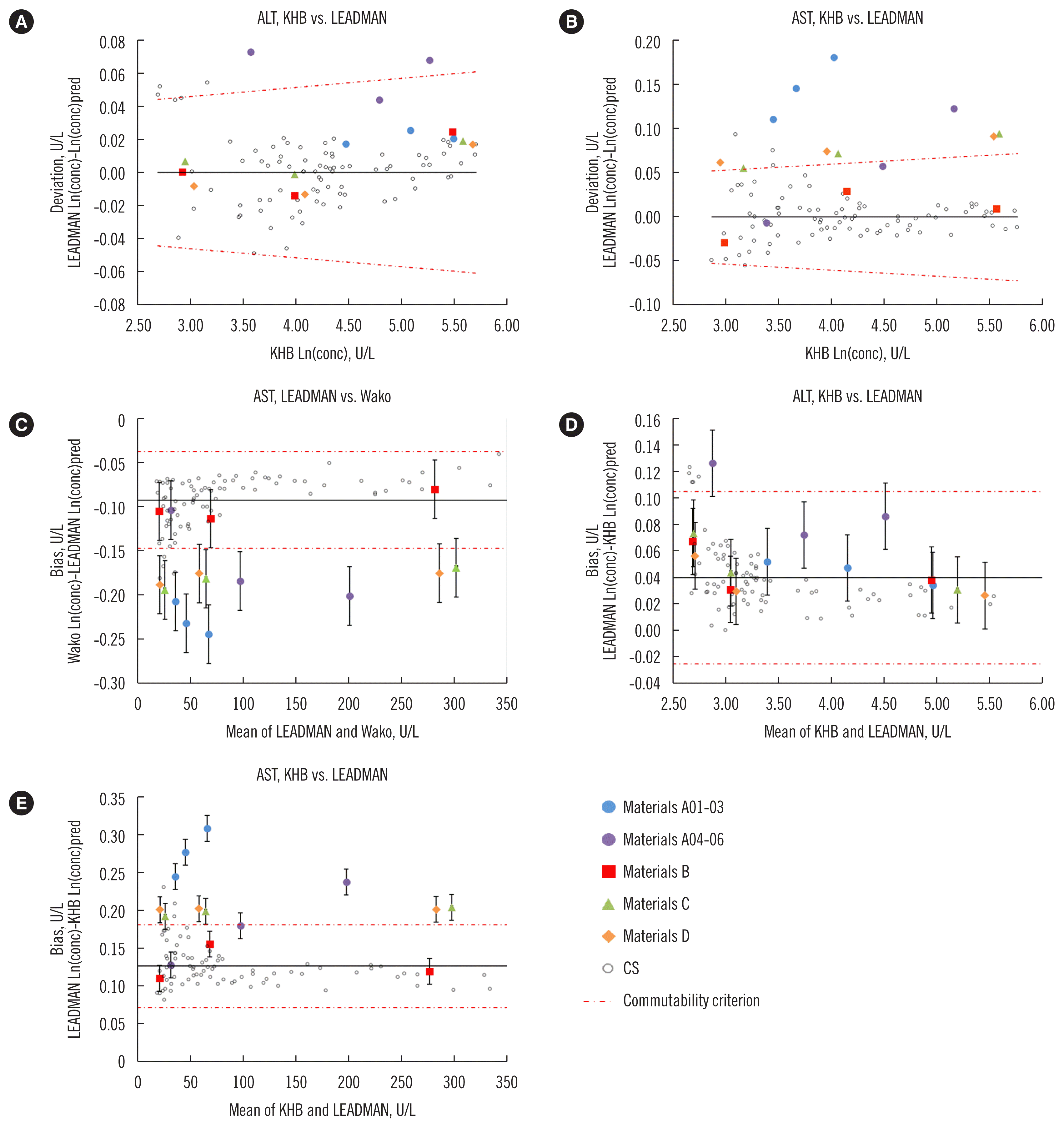1. Kwo PY, Cohen SM, Lim JK. ACG clinical guideline: evaluation of abnormal liver chemistries. Am J Gastroenterol. 2017; 112:18–35.


2. Zhong K, Wang W, Falin H, Wang Z. Investigation and analysis of current application status of testing items of clinical laboratories in China. Chin J Lab Med. 2015; 38:637–41.
3. Krishnamurthy S, Korenblat KM, Scott MG. Persistent increase in aspartate aminotransferase in an asymptomatic patient. Clin Chem. 2009; 55:1573–5.


4. Miller WG, Myers GL. Commutability still matters. Clin Chem. 2013; 59:1291–3.


5. Miller WG, Jones GR, Horowitz GL, Weykamp C. Proficiency testing/external quality assessment: current challenges and future directions. Clin Chem. 2011; 57:1670–80.


6. Cobbaert C, Weykamp C, Franck P, de Jonge R, Kuypers A, Steigstra H, et al. Systematic monitoring of standardization and harmonization status with commutable EQA-samples—Five year experience from the Netherlands. Clin Chim Acta. 2012; 414:234–40.

7. Zhang T, Zeng J, Wang M, Zhang C, Zhang J, Zhao H, et al. The commutability of reference materials for serum glucose measurements. Chin J Lab Med. 2015; 38:296–300.
8. Zhang S, Zeng J, Zhang C, Li Y, Zhao H, Cheng F, et al. Commutability of possible external quality assessment materials for cardiac troponin measurement. PLoS One. 2014; 9:e102046.

9. Ge M, Zhao H, Yan Y, Zhang T, Zeng J, Wang Y, et al. Evaluation of the bias of serum magnesium measurements and the commutability of processed materials. Clin Lab. 2016; 62:921–30.


10. Meng Q, Zhou W, Zhang C, Zeng J, Zhao H, Zhang T, et al. Serum triglyceride measurements: the commutability of reference materials and the accuracy of results. Clin Chem Lab Med. 2017; 55:1284–90.


11. Zeng J, Qi T, Wang S, Zhang T, Zhou W, Zhao H, et al. Commutability of control materials for external quality assessment of serum apolipoprotein A-I measurement. Clin Chem Lab Med. 2018; 56:789–95.


12. CLSI. Characterization and qualification of commutable reference materials for laboratory medicine; approved guideline. EP30-A. Wayne, PA: Clinical and Laboratory Standards Institute;2010.
15. Budd JR, Weykamp C, Rej R, MacKenzie F, Ceriotti F, Greenberg N, et al. IFCC Working Group Recommendations for Assessing Commutability Part 3: Using the calibration effectiveness of a reference material. Clin Chem. 2018; 64:465–74.


16. Schumann G, Bonora R, Ceriotti F, Férard G, Ferrero CA, Franck PF, et al. IFCC primary reference procedures for the measurement of catalytic activity concentrations of enzymes at 37 degrees C. International Federation of Clinical Chemistry and Laboratory Medicine. Part 4. Reference procedure for the measurement of catalytic concentration of alanine aminotransferase. Clin Chem Lab Med. 2002; 40:718–24.


17. Schumann G, Bonora R, Ceriotti F, Férard G, Ferrero CA, Franck PF, et al. IFCC primary reference procedures for the measurement of catalytic activity concentrations of enzymes at 37 degrees C. International Federation of Clinical Chemistry and Laboratory Medicine. Part 5. Reference procedure for the measurement of catalytic concentration of aspartate aminotransferase. Clin Chem Lab Med. 2002; 40:725–33.


18. Westerhuis LW, Hafkenscheid JC. Apoenzyme content of serum aminotransferases in relation to plasma pyridoxal-5′-phosphate concentration. Clin Chem. 1983; 29:789–92.


21. Nishino T, Yachie-Kinoshita A, Hirayama A, Soga T, Suematsu M, Tomita M. In silico modeling and metabolome analysis of long-stored erythrocytes to improve blood storage methods. J Biotechnol. 2009; 144:212–23.


22. Yang P, Zhou J, Kang Y, Gong L, Zhang J, Yu J, et al. Mannitol-adenine-phosphate: a novel solution for intraoperative blood salvage. Transfusion. 2014; 54:1146–52.


23. Zou L, Zhao H, Wang D, Wang M, Zhang C, Xiao F. Expression and purification of a functional recombinant aspartate aminotransferase (AST) from Escherichia coli. J Microbiol Biotechnol. 2014; 24:998–1003.


24. Carobene A, R⊘raas T, S⊘lvik UØ, Sylte MS, Sandberg S, Guerra E, et al. Biological variation estimates obtained from 91 healthy study participants for 9 enzymes in serum. Clin Chem. 2017; 63:1141–50.


25. Deprez L, Toussaint B, Zegers I, Schimmel H, Grote-Koska D, Klauke R, et al. Commutability assessment of candidate reference materials for pancreatic alpha-amylase. Clin Chem. 2018; 64:1193–202.

26. Korzun WJ, Nilsson G, Bachmann LM, Myers GL, Sakurabayashi I, Nakajima K, et al. Difference in bias approach for commutability assessment: application to frozen pools of human serum measured by 8 direct methods for HDL and LDL cholesterol. Clin Chem. 2015; 61:1107–13.


27. CLSI. Preparation and validation of commutable frozen human serum pools as secondary reference materials for cholesterol measurement procedures; approved guideline. C37-A. Wayne, PA: Clinical and Laboratory Standards Institute;1999.
28. Cobbaert C, Weykamp C, Baadenhuijsen H, Kuypers A, Lindemans J, Jansen R. Selection, preparation, and characterization of commutable frozen human serum pools as potential secondary reference materials for lipid and apolipoprotein measurements: study within the framework of the Dutch project “Calibration 2000”. Clin Chem. 2002; 48:1526–38.


29. Eto A, Shiki A, Chikaura Y, Oka T, Nakano NI. Multienzyme control serum (Seraclear-HE) containing human enzymes from established cell lines and other sources. 1: Preparation and properties. Clin Chem. 1995; 41:872–80.


30. Nakano NI, Eto A, Chikaura Y, Oishi T. Multienzyme control serum (Seraclear-HE) containing human enzymes from established cell lines and other sources. 2: Evaluation as candidate working enzyme reference material for alanine and aspartate aminotransferases. Clin Chem. 1995; 41:881–91.

31. Rami L, Roura M, Canalias F. Evaluation of commutability of several materials for harmonization alkaline phosphatase catalytic concentration measurements. Clin Chim Acta. 2012; 413:1249–54.






 PDF
PDF Citation
Citation Print
Print



 XML Download
XML Download